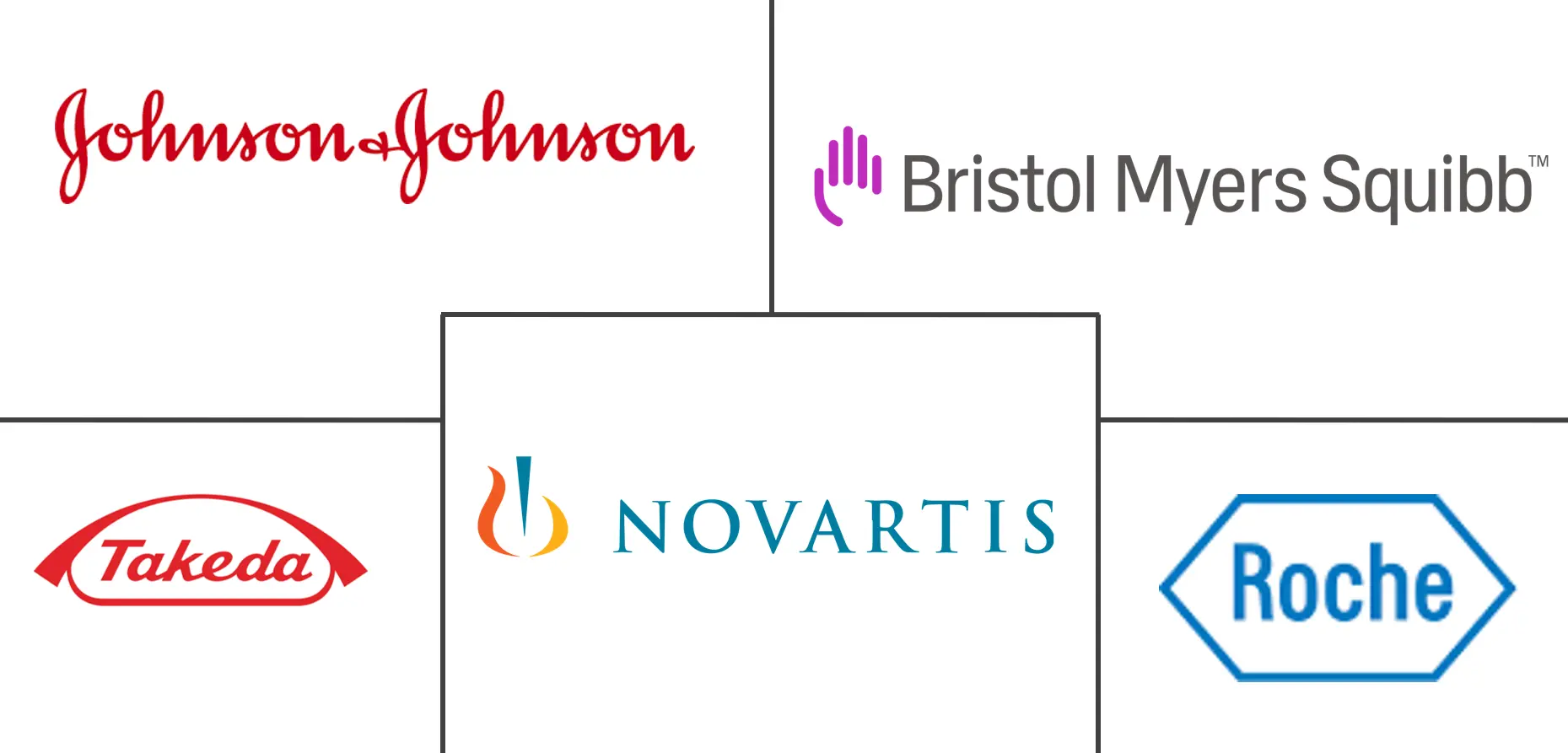Orphan Drugs Market Size and Share
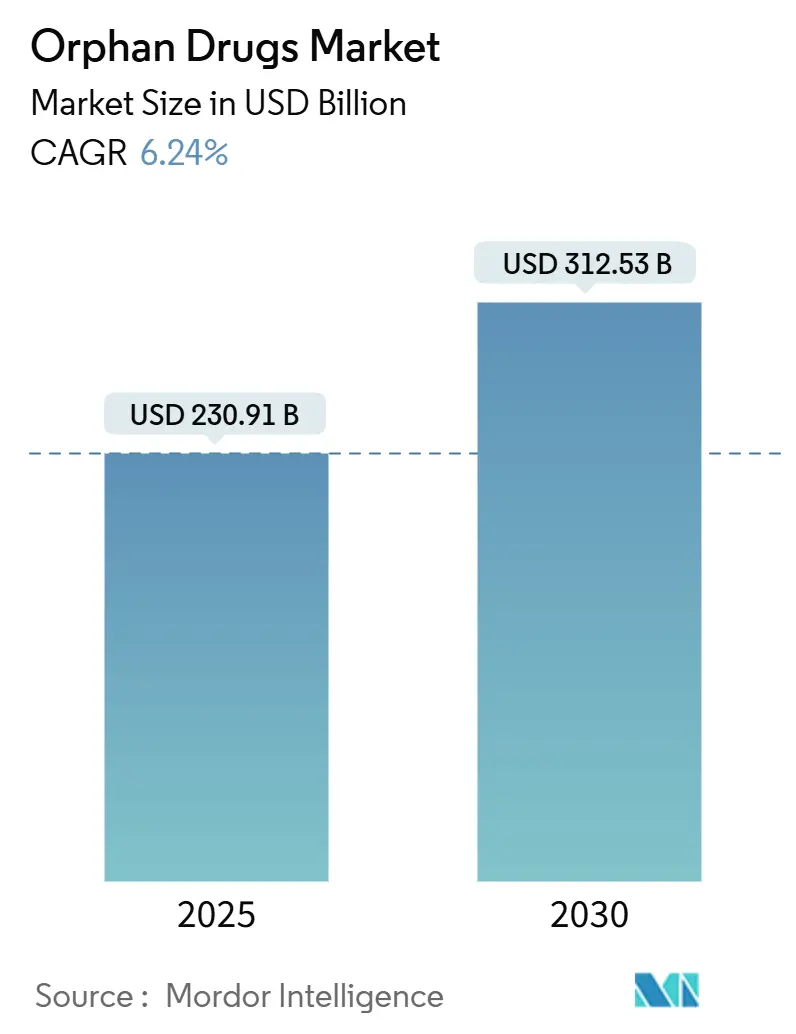
Orphan Drugs Market Analysis by Mordor Intelligence
The orphan drugs market stood at USD 230.91 billion in 2025 and is projected to reach USD 312.53 billion by 2030, progressing at a 6.24% CAGR. Sustained growth reflects regulatory incentives, gene- and cell-therapy breakthroughs, and persistent unmet needs across more than 7,000 rare diseases. Dominance of biologics, particularly gene therapies and monoclonal antibodies, underscores the pivot toward curative one-time treatments. North America leads on the back of robust designation programs and strong reimbursement, while Asia-Pacific gains momentum as policy frameworks expand. Competitive dynamics show large pharmaceutical firms acquiring specialty biotech innovators to secure pipeline depth, and artificial-intelligence-enabled adaptive trials are compressing development cycles to capitalize on extended exclusivity periods.
Key Report Takeaways
- By drug type, biologics held 65.65% of the orphan drugs market share in 2024 and are advancing at an 8.84% CAGR through 2030.
- By disease area, oncologic diseases led with 40.53% revenue share in 2024, while hematologic and immunologic diseases post the fastest 10.35% CAGR to 2030.
- By route of administration, parenteral products captured 78.82% share of the orphan drugs market size in 2024, yet oral formulations are forecast to expand at 11.26% CAGR.
- By distribution channel, hospital pharmacies controlled 68.82% of revenue in 2024; online pharmacies represent the fastest growth at 9.26% CAGR.
- By geography, North America retained 42.82% share of the orphan drugs market in 2024, whereas Asia-Pacific is set to register the strongest 11.62% CAGR through 2030.
Global Orphan Drugs Market Trends and Insights
Drivers Impact Analysis
| Driver | (~) % Impact on CAGR Forecast | Geographic Relevance | Impact Timeline |
|---|---|---|---|
| Surge in gene & cell-therapy platforms for ultra-rare disorders | +2.1% | North America & EU leading, APAC emerging | Medium term (2-4 years) |
| Rising prevalence of rare diseases | +1.8% | Global, higher in aging North America & Europe | Long term (≥ 4 years) |
| Market exclusivity for orphan-designated drugs | +1.5% | Global, strongest in regulated markets | Long term (≥ 4 years) |
| Favorable government incentives & tax credits | +1.2% | North America & EU primarily, expanding to APAC | Medium term (2-4 years) |
| AI-driven adaptive trials shrinking timelines | +0.8% | Global, concentrated in major research hubs | Short term (≤ 2 years) |
| Repurposing of shelved Phase II assets | +0.6% | Global, driven by pharmaceutical companies | Short term (≤ 2 years) |
| Source: Mordor Intelligence | |||
Surge in Gene & Cell-Therapy Platforms for Ultra-Rare Disorders
Gene therapy is redefining the orphan drugs market by targeting causal mutations rather than symptomatic pathways. The November 2024 FDA approval of KEBILIDI for aromatic L-amino acid decarboxylase deficiency demonstrated clinically meaningful motor improvements after a single infusion[1]Office of the Commissioner, “FDA Approves First Gene Therapy for Treatment of Aromatic L-amino Acid Decarboxylase Deficiency,” fda.gov. Similar momentum appears in Europe, where LENMELDY secured EMA clearance for metachromatic leukodystrophy during 2024, validating accelerated biomarker-driven pathways. A convergence of CRISPR editing with adeno-associated virus delivery enables viable business models even when global prevalence is below 1,000 individuals. Premium pricing that can exceed USD 2 million per course underpins returns on the specialized infrastructure that manufacturers must build. Early movers with vertically integrated vector manufacturing lines attain formidable entry barriers and pricing power.
AI-Driven Adaptive Trials Shrinking Development Timelines
Artificial-intelligence platforms allow protocol adjustments based on interim efficacy and safety signals, reducing patient exposure and shaving 18–24 months off timelines relative to fixed designs[2]Aman Mourya, “AI-powered clinical trials and regulatory transparency,” SpringerLink, springer.com. The FDA workshop on AI in 2024 clarified documentation expectations, fostering faster yet accountable pathways. Machine-learning algorithms enhance patient stratification, critical in trials where cohorts seldom exceed 200 participants. Sponsors thereby achieve regulatory-grade evidence with smaller N sizes, enabling rapid entry into the orphan drugs market ahead of exclusivity cliffs. Large firms with in-house data-science teams now dominate adaptive-trial capability, widening the competitive gap.
Favorable Government Incentives & Tax Credits
The U.S. Orphan Drug Tax Credit refunds 25% of eligible clinical costs, while the FDA’s grants program directly finances proof-of-concept studies for diseases such as ALS. Europe matches with 10-year market exclusivity and fee waivers, having cleared more than 200 orphan medicines since 2000. China’s CARE initiative and India’s national rare disease policy broaden the incentive footprint across Asia, trimming effective project costs by as much as 60% compared with traditional development. Public-sector support thereby sustains a pipeline that now addresses conditions once deemed commercially unviable.
Repurposing of Shelved Phase II Assets for Niche Indications
Guidelines from the International Rare Diseases Research Consortium help developers mine compound libraries for new rare-disease matches. Empagliflozin’s repositioning for Lafora disease typifies the strategy, as preclinical data uncovered neuroprotective actions beyond SGLT2 inhibition. Existing safety dossiers cut two to three years from the approval clock, a boon for smaller biotechs short on discovery budgets. Licensing deals let originators salvage sunk R&D outlays, while acquirers secure rapid entry to the orphan drugs market with reduced risk.
Restraints Impact Analysis
| Restraint | (~) % Impact on CAGR Forecast | Geographic Relevance | Impact Timeline |
|---|---|---|---|
| High per-patient treatment cost | -1.4% | Global, most pronounced in price-sensitive markets | Medium term (2-4 years) |
| Payer scrutiny on indication creep & real-world value | -1.1% | North America & EU primarily | Short term (≤ 2 years) |
| Limited patient pool for trials & marketing | -0.9% | Global, acute in ultra-rare diseases | Long term (≥ 4 years) |
| Legislative proposals to shorten exclusivity windows | -0.8% | US & EU, potential global spillover | Medium term (2-4 years) |
| Source: Mordor Intelligence | |||
High Per-Patient Treatment Cost
Median annual therapy costs surpassed USD 256,000 in 2024, and single-dose gene therapies frequently exceed USD 2 million. Payers respond with prior authorization and outcomes-based contracts, especially when treatments later expand into broader populations. European HTA bodies increasingly demand post-launch evidence of durable benefit, pushing sponsors to fund long-term registries that add material expense. Pricing strategy therefore remains a delicate equilibrium between recouping innovation investment and maintaining reimbursement viability.
Payer Scrutiny on “Indication Creep”
The Inflation Reduction Act allows price renegotiation once a drug secures non-orphan indications, discouraging expansion and sharpening focus on value demonstration. Outcome-based agreements in Europe mirror this stance, tying reimbursement to real-world effectiveness. Pharmaceutical firms must now budget for health-economics studies early in development to preserve access, and some pipelines are being reprioritized away from incremental indications to avoid margin erosion.
Segment Analysis
By Drug Type: Biologics Lead Innovation Wave
Biologics accounted for 65.65% of revenue in 2024 and will outpace small molecules at an 8.84% CAGR through 2030. Twenty-five percent of FDA approvals in 2024 were monoclonal antibodies or gene therapies, signaling sustained preference for modality platforms enabling precision interventions. The orphan drugs market size for biologics is forecast to reach USD 205 billion by 2030, buoyed by one-time curative therapies that command premium price tags. Non-biologics still retain share in metabolic disorders via repurposed small molecules, yet competitive differentiation is narrowing as genetic medicines address underlying enzymatic deficits more effectively. Manufacturers scaling viral vector plants gain cost leverage, whereas small-molecule producers rely on formulation innovation and life-cycle management to remain relevant.
Gene-therapy exemplars include LYFGENIA for sickle-cell disease and KEBILIDI for aromatic L-AAD deficiency, both demonstrating transformative clinical benefit with single administrations. Manufacturing complexity elevates barrier to entry; consequently, CDMO partnerships and in-house vector capacity have become acquisition triggers. Regulatory bodies demand robust potency assays and long-term follow-up, prompting companies to establish multidisciplinary surveillance programs. Intellectual-property strategies focus on capsid engineering and promoter optimization, consolidating competitive moats within the orphan drugs market.
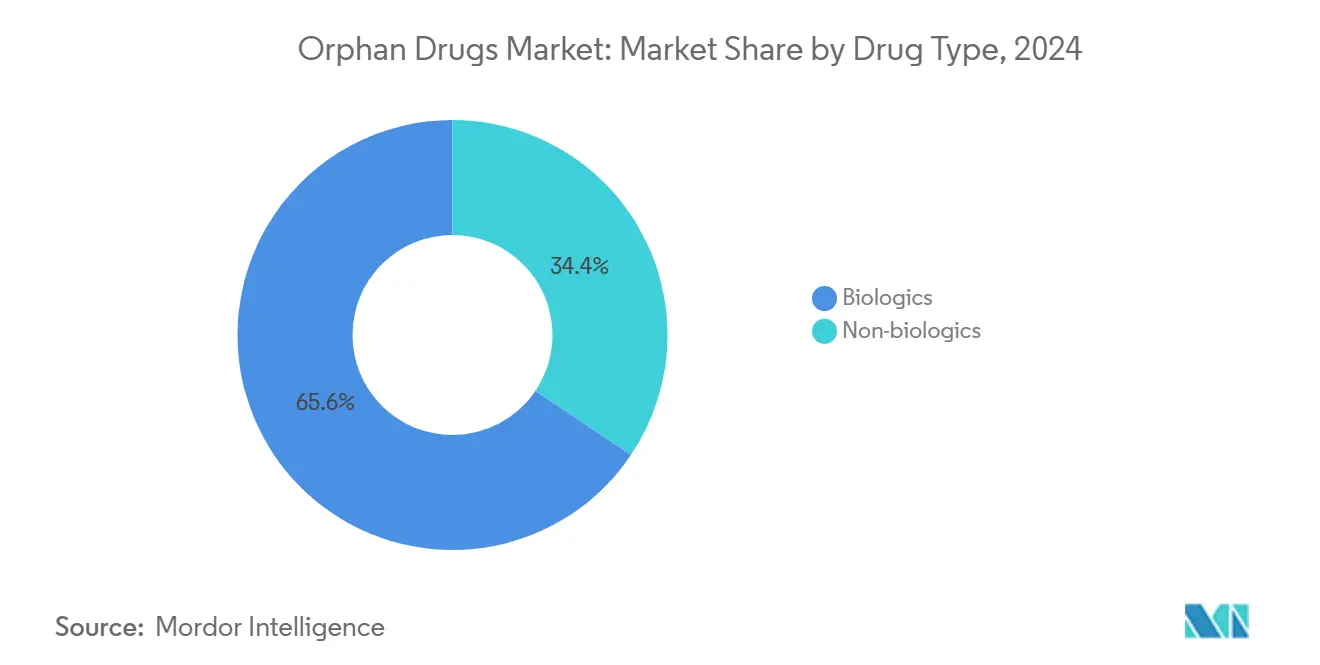
By Disease Area: Oncologic Dominance Faces Hematologic Challenge
Oncologic diseases retained 40.53% share in 2024 but exhibit a slower growth pace as saturation in hematologic malignancies emerges. The orphan drugs market share for oncology stood at 41% in 2024 and is expected to edge marginally lower as newer categories accelerate. EMA approval of Ordspono for relapsed follicular lymphoma underscores continued innovation in T-cell-redirecting antibodies. However, hematologic and immunologic diseases are advancing at a 10.35% CAGR propelled by factor-replacement alternatives such as concizumab and fitusiran.
Neurologic gene therapies, including tofersen for SOD1-ALS, broaden the pipeline and highlight biomarker-driven approvals. Metabolic disease programs leverage next-generation enzyme replacement and mRNA therapy, while infectious-disease rarities such as viral hemorrhagic fevers attract niche funding. Investors track therapeutic novelty and regulatory momentum when assessing portfolio weightings across these segments.
By Route of Administration: Oral Innovation Challenges Parenteral Dominance
Parenteral modalities held 78.82% revenue share in 2024 due to the stability needs of biologics. Yet oral formats are forecast for an 11.26% CAGR as nano-carrier and permeability-enhancer technologies progress. The orphan drugs market size for oral formulations is projected to exceed USD 35 billion by 2030. Clinical successes in peptide absorption using pH-responsive coatings validate earlier preclinical findings. Patient preference surveys show 72% of primary hyperoxaluria patients favor self-administered options, incentivizing sponsors to re-engineer existing injectables toward oral alternatives.
Device-assisted subcutaneous infusers and implantables further diversify delivery, supporting chronic regimens in immunologic conditions. Inhaled biologics address pulmonary rare diseases, though cold-chain demands remain challenging. Supply-chain digitization and at-home care models reduce hospital resource burdens, aligning with healthcare-system imperatives for cost containment.
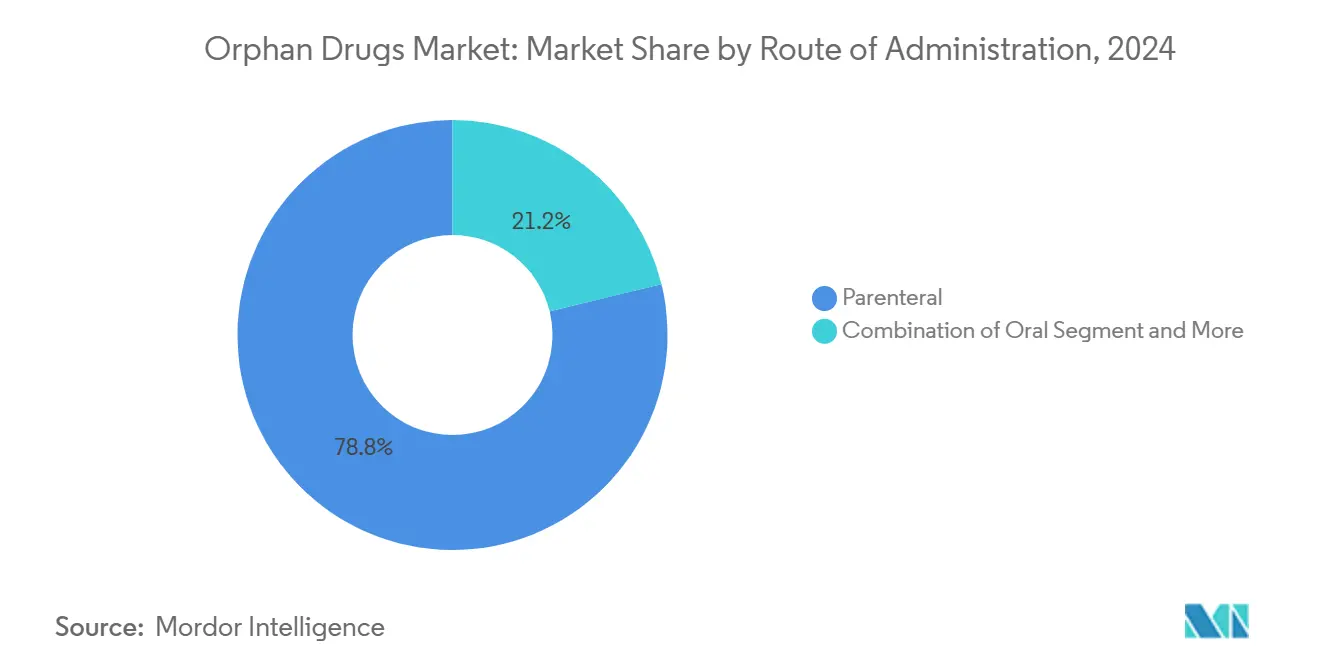
Note: Segment shares of all individual segments available upon report purchase
By Distribution Channel: Specialty Networks Drive Online Growth
Hospital pharmacies commanded 68.82% sales in 2024 because complex handling protocols favor center-based dispensing. Nevertheless, online specialty hubs are growing 9.26% annually, leveraging telehealth and direct-to-patient logistics. Integrated models, such as Lurie Children’s planned pediatric specialty pharmacy, illustrate convergence of clinical expertise with last-mile delivery.
Retail channels remain limited to oral therapies and supportive medications, yet partnerships with specialty pharmacies enable expanded therapeutic offerings without significant infrastructure upgrades. Blockchain-based track-and-trace systems improve temperature monitoring and counterfeit mitigation. As payer contracts increasingly bundle drug and service reimbursement, specialty networks that provide adherence programs gain negotiating leverage across the orphan drugs market.
Geography Analysis
North America captured 42.82% of global revenue in 2024 and continues to benefit from 7-year exclusivity under the Orphan Drug Act plus the 25% clinical-trial tax credit[3]Jonathan Cardella, “Orphan Drugs & the R&D Tax Credit,” StrikeTax.com, striketax.com. Recent FDA approvals of XOLREMDI for WHIM syndrome and RYT-ELO for high-risk myelodysplastic syndromes illustrate regulator responsiveness. Nonetheless, the Inflation Reduction Act introduces price-renegotiation risk if products expand beyond single orphan indications, prompting strategic caution on label extensions.
Europe holds a significant portion of the orphan drugs market on the strength of centralized EMA procedures that offer 10-year exclusivity and fee relief. The Critical Medicines Act seeks to build regional manufacturing resilience and streamline shortages, but draft reforms propose reducing regulatory-data protection to nine years, potentially tempering investment enthusiasm. Managed-entry agreements and outcome-based contracts dominate payer negotiations, ensuring access while controlling spend.
Asia-Pacific is the fastest-growing region at 11.62% CAGR to 2030, underpinned by the CARE program in China and India’s rare-disease policy grants. The region’s large populations ease trial recruitment, and rising disposable incomes support premium therapies. Still, fragmented reimbursement and variable epidemiological data limit immediate uptake, requiring sponsors to develop localized engagement strategies.
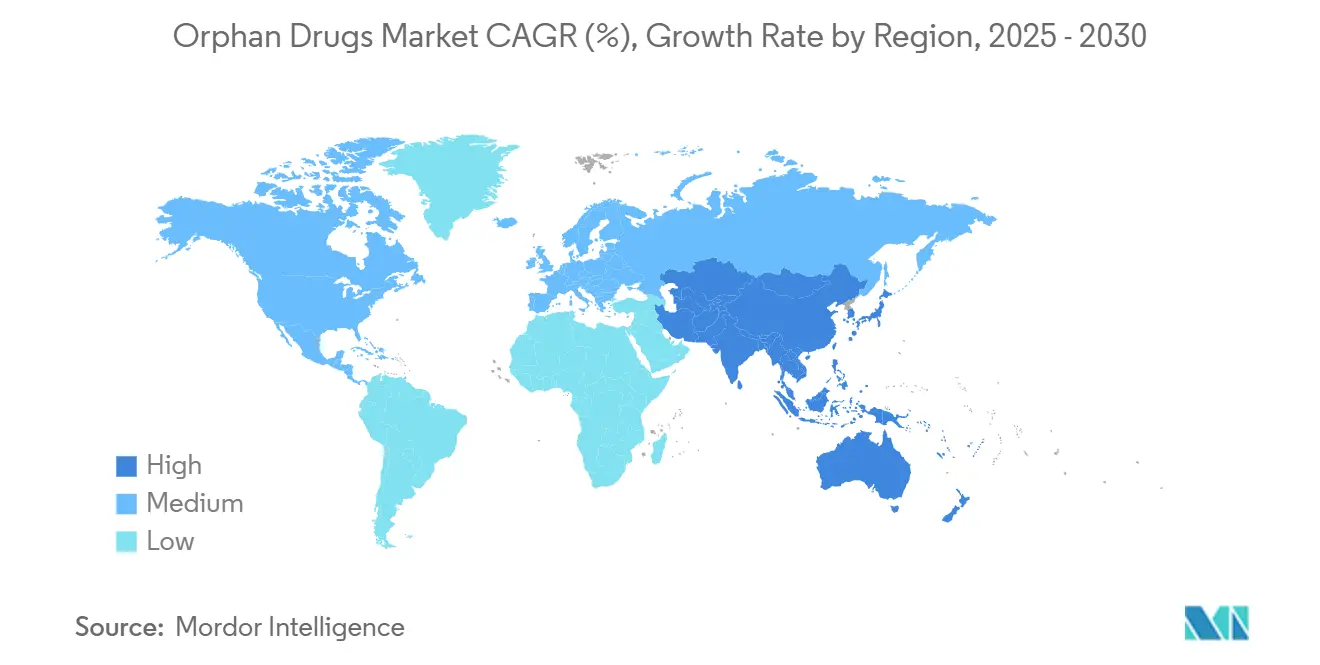
Competitive Landscape
The orphan drugs market features moderate fragmentation as large pharmaceutical companies acquire niche innovators for differentiated assets. Johnson & Johnson, Novartis, and Roche collectively hold significant revenue share, while dozens of smaller biotechs deliver pipeline novelty. Sanofi’s planned USD 300 million partnership with Orano Med targets radioligand therapies for rare cancers, reflecting a trend toward modality diversification.
M&A volumes stayed elevated through early 2025, with the Mallinckrodt-Endo merger aimed at operational scale and complementary brands such as XIAFLEX and Acthar Gel. Strategic collaborations help mitigate manufacturing risk in gene therapy; Novartis’ investment in viral-vector CDMOs exemplifies vertical-integration ambitions. AI competence has emerged as a strategic differentiator, prompting talent acquisition and academic partnerships to enhance data-driven trial design.
Intellectual-property strategies emphasize broad platform patents around vector engineering and promoter sequences, thereby extending protective moats beyond single assets. Market entrants face high capital intensity for GMP-vector facilities and long-term safety monitoring obligations, reinforcing incumbents’ edge. As regulators call for post-market evidence, firms with real-world data infrastructure enjoy smoother renewals and label expansions.
Orphan Drugs Industry Leaders
-
Takeda Pharmaceutical Company Limited
-
Novartis AG
-
Johnson & Johnson
-
F. Hoffmann-La Roche Ltd
-
Bristol-Myers Squibb Co.
- *Disclaimer: Major Players sorted in no particular order
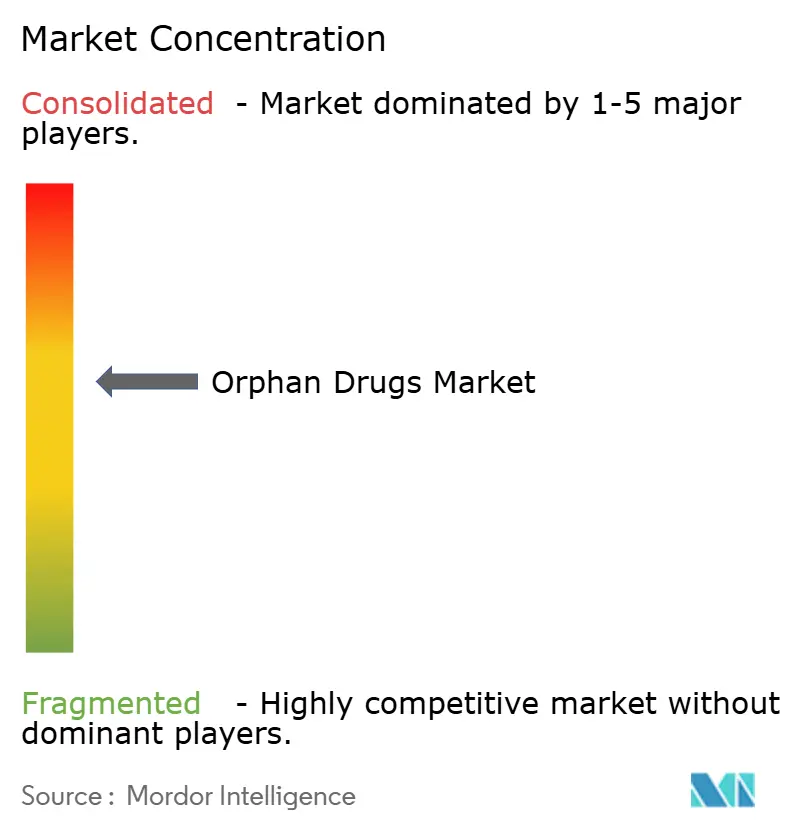
Recent Industry Developments
- March 2025: Mallinckrodt and Endo announced merger to create a diversified pharmaceuticals leader focused on rare diseases.
- December 2024: FDA approved Alhemo (concizumab-mtci) for prophylaxis in hemophilia A or B patients with inhibitors.
- November 2024: FDA approved KEBILIDI, the first gene therapy for aromatic L-AAD deficiency.
Research Methodology Framework and Report Scope
Market Definitions and Key Coverage
Our study defines the orphan drugs market as prescription therapeutics that have received or actively seek an orphan designation to treat a single rare disease, typically one affecting fewer than 200,000 people in the United States or fewer than five in 10,000 in Europe. Value is tracked at ex-manufacturer prices for all originator biologic and small-molecule products that are either approved or in commercial launch across 17 key countries.
Scope exclusion: We exclude compounded formulations, named-patient imports, and off-label sales for non-rare indications.
Segmentation Overview
- By Drug Type
- Biologics
- Non-biologics
- By Disease Area
- Oncologic Diseases
- Hematologic & Immunologic Diseases
- Neurologic Diseases
- Metabolic Diseases
- Infectious Diseases
- Other Rare Diseases
- By Route of Administration
- Parenteral
- Oral
- Others (Inhalation, Topical, Implantable)
- By Distribution Channel
- Hospital Pharmacies
- Retail Pharmacies
- Online Pharmacies
- Geography
- North America
- United States
- Canada
- Mexico
- Europe
- Germany
- United Kingdom
- France
- Italy
- Spain
- Rest of Europe
- Asia-Pacific
- China
- Japan
- India
- South Korea
- Australia
- Rest of Asia-Pacific
- Middle East and Africa
- GCC
- South Africa
- Rest of Middle East and Africa
- South America
- Brazil
- Argentina
- Rest of South America
- North America
Detailed Research Methodology and Data Validation
Primary Research
Mordor analysts interviewed clinical geneticists, reimbursement advisers, rare-disease foundations, and market-access managers across North America, Europe, and Asia-Pacific. The discussions clarified patient journey bottlenecks, average annual therapy cost, and real-world uptake curves, which we then triangulated with desk findings to fine-tune incidence-to-treated ratios.
Desk Research
We began with publicly available datasets such as the US FDA Orphan Drug Product database, EMA COMP opinions, the NIH GARD registry, and Orphanet prevalence tables, which supplied prevalence cut-offs and designation counts. Trade statistics from UN Comtrade, peer-reviewed articles archived on PubMed, and reports from patient advocacy groups added epidemiological context. Company 10-Ks, investor decks, and Dow Jones Factiva news feeds helped verify launch dates and revenue run-rates, while D&B Hoovers offered hard financials when filings were absent. These references illustrate, not exhaust, the secondary sources consulted.
Market-Sizing & Forecasting
A top-down prevalence-to-treated-cohort build was first executed for each disease, then corroborated through selective bottom-up revenue roll-ups from major orphan-drug suppliers. Key variables like diagnostic rate progress, clinical-trial success probability, average therapy cost evolution, regulatory designation velocity, and payor reimbursement ratios drive the model. Multivariate regression, cross-validated against historical sales and policy inflection points, underpins five-year forecasts; gaps in bottom-up data are bridged by applying region-specific uptake multipliers vetted in expert calls.
Data Validation & Update Cycle
Outputs undergo anomaly checks, peer review, and senior analyst sign-off. We refresh the model annually; interim updates are triggered by landmark approvals or pricing reforms, ensuring buyers receive an up-to-date view every time they access the report.
Why Our Orphan Drugs Baseline Earns Maximum Trust
Published estimates vary, and we acknowledge that disparity up front.
Divergences usually stem from differing drug-type inclusion, forecast cadence, or how pipeline attrition is handled.
Benchmark comparison
| Market Size | Anonymized source | Primary gap driver |
|---|---|---|
| USD 230.91 B (2025) | Mordor Intelligence | - |
| USD 216.55 B (2025) | Global Consultancy A | Counts only biologics and oncology therapies, omitting small-molecule orphan launches |
| USD 189.17 B (2024) | Industry Association B | Earlier base year and uniform 12% CAGR, with no currency-year normalization |
| USD 179.50 B (2023) | Trade Journal C | Relies on company filings without adjusting multi-indication revenues or parallel trade leakage |
These comparisons show that when scope rigor, refresh frequency, and variable transparency are aligned, as in Mordor's approach, the resulting baseline stands out as the most balanced and reproducible reference for strategic decision-making.
Key Questions Answered in the Report
What is the current size of the global orphan drugs market and how fast is it growing?
The market is valued at USD 230.91 billion in 2025 and is projected to reach USD 312.53 billion by 2030, reflecting a 6.24% CAGR.
Which drug type holds the largest share of the orphan drugs market?
Biologics lead with 65.65% market share in 2024 and are expanding at an 8.84% CAGR through 2030.
Which region is expected to grow the fastest in the orphan drugs market?
Asia-Pacific is forecast to post the strongest 11.62% CAGR between 2025 and 2030.
What is the primary growth driver for the orphan drugs market?
Breakthrough gene- and cell-therapy platforms targeting ultra-rare disorders are adding about 2.1 percentage points to the market’s CAGR.
What is the most significant restraint affecting market expansion?
High per-patient treatment costs—often exceeding USD 300,000 per year or USD 2 million for one-time gene therapies—are exerting downward pressure on adoption.
How is artificial intelligence influencing orphan drug development?
AI-enabled adaptive clinical trials are shortening development timelines by 18–24 months, helping sponsors reach the market sooner while maintaining robust evidence standards.
Page last updated on:
